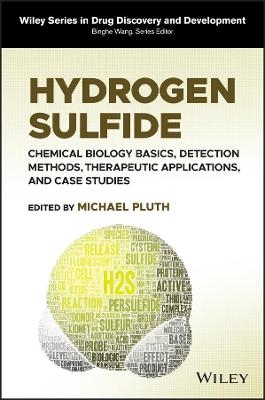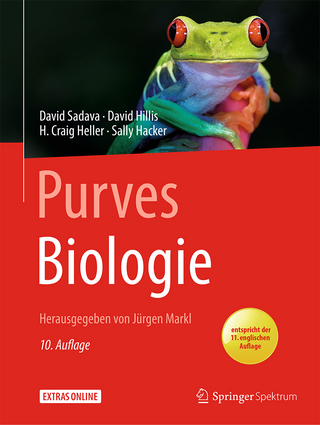
Hydrogen Sulfide
John Wiley & Sons Inc (Verlag)
978-1-119-79987-0 (ISBN)
Research on hydrogen sulfide (H2S) spans diverse disciplines including chemistry, biology, and physiology. In recent years, new materials and approaches have been developed to deliver H2S and related reactive sulfur species in various clinical contexts. Although many biological pathways involving H2S are complex, all are governed by fundamental chemical interactions between reactive sulfur species and other molecular entities.
Hydrogen Sulfide: Chemical Biology Basics, Detection Methods, Therapeutic Applications, and Case Studies provides the foundation required for understanding the fundamental chemical biology of H2S while highlighting the compound’s therapeutic potential and medicinal applications. This book covers key aspects of H2S chemical biology, including the fundamental chemistry of reactive sulfur species; the measurement, detection, and delivery of H2S in biological environments; and the therapeutic and medicinal uses of exogenous H2S delivery in various pharmacologically relevant systems. Throughout the text, editor Michael Pluth and chapter contributors discuss the opportunities and future of the multidisciplinary field.
Provides approaches for delivering H2S with relevance to biological and therapeutic applications
Describes complex interactions of H2S with bioinorganic complexes and reactive sulfur, nitrogen, and oxygen species
Summarizes advances in available tools to detect, measure, and modulate H2S levels in biological environments, such as real-time methods for H2S fluorescence imaging in live cell and animal systems
Helps readers understand known systems and make connections to new and undiscovered pathways and mechanisms of action
Includes in-depth case studies of different systems in which H2S plays an important role
Hydrogen Sulfide: Chemical Biology Basics, Detection Methods, Therapeutic Applications, and Case Studies is an important source of current knowledge for researchers, academics, graduate students, and industrial scientists in the fields of redox biology, hydrogen sulfide research, and medicinal chemistry of small biological molecules.
MICHAEL D. PLUTH, PhD is a Professor at the University of Oregon in the Department of Chemistry and Biochemistry. He is also a member of the Materials Science Institute, Knight Campus for Accelerating Scientific Impact, and Institute of Molecular Biology at the University of Oregon.
Preface xvii
List of Contributors xix
1 Fundamental and Biologically Relevant Chemistry of H2S and Related Species 1
Jon M. Fukuto
List of Abbreviations 1
1.1 Introduction 2
1.2 The Chemical Biology of H2S 2
1.2.1 Basic Chemical Properties of H2S 3
1.2.2 H2S Redox Chemistry 4
1.2.3 Reactions of H2S with Metals/Metalloproteins 5
1.2.4 H2S and Sulfheme Formation 6
1.2.5 H2S and Heavy Metals 7
1.3 H2S Reactions with Other Sulfur Species 8
1.3.1 Sulfane Sulfur 8
1.3.2 Generation of RSSH 8
1.3.3 RSH Versus RSSH Comparison 9
1.3.4 RSSH Interactions with Metals/Metalloproteins 14
1.3.5 The Electrophilicity of RSSH 14
1.3.6 Higher-Order Polysulfides 15
1.3.7 RSSH Instability 16
1.4 The Biochemical Utility of RSSH 17
1.5 Summary/Conclusion 18
References 18
2 Signaling by Hydrogen Sulfide (H2S) and Polysulfides (H2Sn) and the Interaction with Other Signaling Pathways 27
Hideo Kimura
List of Abbreviations 27
2.1 Introduction 28
2.2 Determination of the Endogenous Concentrations of H2S 29
2.3 H2S and H2Sn as Signaling Molecules 31
2.4 Crosstalk Between H2S and NO 32
2.4.1 The Chemical Interaction of H2S and NO Produces H2Sn 32
2.4.2 Regulation of NO-Producing Enzymes by H2S and Vice Versa 33
2.5 Cytoprotective Effect of H2S, H2Sn, and H2SO3 34
2.6 Energy Formation in Mitochondria with H2S 34
2.7 S-Sulfurated Proteins and Bound Sulfane Sulfur in Cells 35
2.8 Regulating the Activity of Target Proteins by H2S and H2Sn 36
2.8.1 S-Sulfuration by H2S 37
2.8.2 S-Sulfuration by H2Sn 38
2.9 Perspectives 38
Acknowledgments 40
Author Disclosure Statement 41
References 41
3 Persulfides and Their Reactions in Biological Contexts 49
Dayana Benchoam, Ernesto Cuevasanta, Matías N. Möller, and Beatriz Alvarez
List of Abbreviations 49
3.1 Persulfides Are Key Intermediates in Sulfur Metabolism and Signaling 49
3.2 Persulfides Are Formed in Biological Systems through Different Pathways 51
3.2.1 Disulfides Form Persulfides in the Presence of H2S 51
3.2.2 Sulfenic Acids Can Also Form Persulfides by Reaction with H2S 53
3.2.3 Other Persulfide Formation Pathways Involve Oxidation Products of H2S 53
3.2.4 Some Sulfur Atoms for Persulfides Are Donated by Free Cysteine 54
3.2.5 Trisulfides Are Also a Source of Persulfides 55
3.2.6 Persulfides Can Be Prepared in the Lab 56
3.3 Persulfides Are More Acidic Than Thiols 56
3.4 Persulfides Are Stronger Nucleophiles Than Thiols 58
3.5 Persulfidation Protects Against Irreversible Oxidation 60
3.6 Persulfides Interact with Metals and Metalloproteins 61
3.7 Persulfides Have Electrophilic Character in Both Sulfur Atoms 62
3.8 Persulfides Are Efficient One-Electron Reductants 63
3.9 Concluding Remarks 64
References 64
4 Hydrogen Sulfide, Reactive Nitrogen Species, and “The Joy of the Experimental Play” 77
Miriam M. Cortese-Krott
4.1 Introduction 77
4.2 Basic Physicochemical Properties of Nitric Oxide and Its Biological Relevant Metabolites 79
4.2.1 Nitric Oxide 79
4.2.2 Nitrite 80
4.2.3 Nitrosothiols (RSNOs) 81
4.3 Basic Physicochemical Properties of H2S and Its Biological Relevant Metabolites 82
4.3.1 H2S/HS− 83
4.3.2 Polysulfides and Persulfide 85
4.4 Inorganic Sulfur–Nitrogen Compounds 86
4.4.1 HSNO/SNO− 87
4.4.2 SSNO− 89
4.4.3 SULFI/NO 90
4.5 Putative Biological Relevance of the NO/H2S Chemical Interaction 90
4.5.1 Pharmacological Activity 90
4.5.2 Putative Sources of SSNO− and SULFI/NO In Vivo 91
4.5.3 Methods of Detection In Vivo 92
4.6 Summary and Conclusions 93
Acknowledgment 93
References 93
5 H2S and Bioinorganic Metal Complexes 103
Zachary J. Tonzetich
List of Abbreviations 103
5.1 Introduction 104
5.2 Basic Ligative Properties of H2S/HS− 105
5.3 H2S and Heme Iron 106
5.4 H2S and Nonheme Iron 112
5.5 H2S Chemistry with Other Metals 122
5.6 H2S Sensing with Transition Metal Complexes 126
5.7 Summary 131
Acknowledgments 134
References 134
6 Measurement of Hydrogen Sulfide Metabolites Using the Monobromobimane Method 143
Xinggui Shen, Ellen H. Speers, and Christopher G. Kevil
List of Abbreviations 143
6.1 Introduction 143
6.1.1 Hydrogen Sulfide: Biological Significance 143
6.1.2 Hydrogen Sulfide Chemistry 144
6.1.3 Bioavailable Sulfide 144
6.2 Monobromobimane: An Optimal Method of Bioavailable Sulfur Detection 145
6.2.1 Monobromobimane Derivatization of Hydrogen Sulfide 146
6.2.2 History of the Monobromobimane Method 147
6.3 Procedures 148
6.3.1 Sulfide-Dibimane Standard Synthesis 148
6.3.2 Bioavailable Sulfide Preparation 149
6.3.3 Monobromobimane Derivatization 149
6.3.4 HPLC with Fluorescence Detection 150
6.3.5 Mass Spectrometry Detection 150
6.4 Caveats and Considerations 151
Acknowledgment 152
Disclosures 152
References 152
7 Fluorescent Probes for H2S Detection: Cyclization-Based Approaches 157
Yingying Wang, Yannie Lam, Caitlin McCartney, Brock Brummett, Geat Ramush, and Ming Xian
List of Abbreviations 157
7.1 Introduction 157
7.2 General Design of Nucleophilic Reaction-Cyclization Based Fluorescent Probes 159
7.2.1 WSP Probes 159
7.2.2 2,2′-Dithiosalicylic Ester-Based Probes 164
7.2.3 Alkyl Halide-Based Probes 166
7.2.4 Diselenide-Based Probes 167
7.2.5 Selenenyl Sulfide-Based Probes 167
7.2.6 Aldehyde Addition-Based Probes 169
7.2.7 Michael Addition-Cyclization Based Probes 175
7.3 Conclusions and Perspectives 177
Acknowledgments 177
References 177
8 Fluorescent Probes for H2S Detection: Electrophile-Based Approaches 183
Long Yi and Zhen Xi
8.1 Introduction 183
8.2 Selected Probes Based on Different Reaction Types 185
8.2.1 Cleavage of C—O Bond 185
8.2.2 Cleavage of C—S Bond 188
8.2.3 Cleavage of C—Cl Bond 190
8.2.4 Michael Addition 191
8.2.5 Cleavage of C—N Bond 193
8.2.6 Reduction of Aryl Azide 193
8.3 Conclusion and Future Prospects 197
References 199
9 Fluorescent Probes for H2S Detection: Metal-Based Approaches 203
Maria Strianese and Claudio Pellecchia
9.1 Introduction 203
9.2 Metal Displacement Approach 205
9.2.1 Copper-Based Systems 205
9.2.2 Zinc-Based Systems 214
9.2.3 Different Metal-Based Systems 216
9.3 Coordinative-Based Approach 218
9.3.1 Metalloporphyrin-Based Systems 218
9.3.1.1 Synthetic Systems 219
9.3.1.2 Natural Systems 220
9.3.2 Salen-Based Systems 220
9.3.3 Systems with Different Organic Ligands 221
9.4 H2S-Mediated Reduction of the Metal Center 223
9.5 Conclusions and Future Outlooks 224
References 225
10 H2S Release from P=S and Se—S Motifs 235
Rynne A. Hankins and John C. Lukesh III
List of Abbreviations 235
10.1 Introduction 235
10.2 H2S Release from P=S Motifs 236
10.2.1 GYY4137: Synthesis and Characterization of H2S Release 237
10.2.2 GYY4137: Biological Studies 238
10.2.3 GYY4137: Mechanistic Studies 240
10.2.4 GYY4137: Structural Modifications and Activity of Analogs 242
10.2.5 JK Donors: Cyclization-Assisted H2S Release from P=S Motifs 248
10.3 H2S Release from Se—S Motifs 249
10.3.1 Acyl Selenylsulfides: Synthesis and Characterization of H2S Release 251
10.3.2 Acyl Selenylsulfides: Mechanistic Studies 251
10.4 Acyl Selenylsulfides: Structural Modifications and Activity of Analogs 253
10.5 Conclusions 253
References 254
11 Hydrogen Sulfide: The Hidden Player of Isothiocyanates Pharmacology 261
Valentina Citi, Eugenia Piragine, Vincenzo Calderone, and Alma Martelli
11.1 Organic Isothiocyanates as H2S-Donors 261
11.2 Organic ITCs and Cardiovascular System 266
11.2.1 Effect of ITCs as H2S Donors in Vascular Inflammation 266
11.2.2 Vasorelaxing Effect of ITCs as H2S Donors 269
11.2.3 Organic ITCs and Heart 270
11.3 Chemopreventive Properties of ITCs 272
11.4 Anti-nociceptive Effects of ITCs 274
11.5 Anti-inflammatory and Antiviral Effects of ITCs 277
11.6 Conclusion 280
Acknowledgment 281
References 281
12 Persulfide Prodrugs 293
Bingchen Yu, Zhengnan Yuan, and Binghe Wang
List of Abbreviations 293
12.1 Introduction 293
12.2 Persulfide Prodrugs 295
12.2.1 Structural Moieties That Have Been Studied for Their Ability to Cage and Release Persulfide Species 296
12.2.2 Enzyme-Sensitive Prodrugs 298
12.2.3 ROS-Sensitive Persulfide Prodrugs 303
12.2.4 pH-Sensitive Persulfide Prodrugs 306
12.2.5 Photo-Sensitive Persulfide Prodrugs 308
12.2.6 H2S Prodrugs That Release H2S Via Persulfide Intermediate 309
12.3 Challenges in Persulfide Prodrug Design and Potential Therapeutic Applications 310
References 313
13 COS-Based H2S Donors 321
Annie K. Gilbert and Michael D. Pluth
13.1 Introduction 321
13.2 Properties of COS 322
13.3 COS-Based H2S Delivery 323
13.3.1 Stimuli Responsive COS/H2S Donors 325
13.3.2 Bio-orthogonal Donor Activation 326
13.3.3 Donors Activated by Nucleophiles 329
13.3.4 Enzyme-Activated Donors 334
13.3.5 pH-Activated Donors 337
13.3.6 Fluorescent Donors 339
13.4 Conclusions and Outlook 341
Acknowledgments 342
References 342
14 Light-Activatable H2S Donors 347
Petr Klán, Tomáš Slanina, and Peter Štacko
14.1 Introduction 347
14.2 Photophysical and Photochemical Concepts 347
14.3 Phototherapeutic Window 349
14.4 Light Sources 349
14.5 (Photo)Physical Properties of H2S 351
14.6 Mechanisms and Examples of H2S Photorelease 351
14.6.1 Photorelease of H2S from Excited State 352
14.6.2 Release of H2S from a Reactive Intermediate 355
14.6.3 Photorelease of Potential H2S Donors 357
14.6.4 Photosensitized H2S Release 362
14.6.5 Photothermal Effect 364
14.7 Outlook 365
Acknowledgment 366
References 366
15 Macromolecular and Supramolecular Approaches for H2S Delivery 373
Sarah N. Swilley-Sanchez, Zhao Li, and John B. Matson
List of Abbreviations 373
15.1 Introduction 375
15.2 H2S-Donating Linear Polymers 377
15.2.1 Pendant H2S Donors 378
15.2.2 H2S Donors on Chain Ends 379
15.2.3 Depolymerizable Polymers for the Release of H2S via COS 383
15.3 H2S Delivery from Branched and Graft Polymer Topologies 384
15.3.1 Graft Polymers for the Delivery of H2S 386
15.4 Polymer Micelles for H2S Delivery 388
15.4.1 H2S Donors Covalently Attached to Polymer Amphiphiles 389
15.5 Polymer Networks for Localized H2S Delivery 394
15.5.1 Physical Encapsulation of H2S Donors Within Networks 394
15.5.2 Covalent Attachment of H2S Donors Within Hydrogels 396
15.6 Other Polymeric Systems for the Encapsulation of H2S Donors 399
15.6.1 Microfibers as H2S Donors 400
15.6.2 Membranes as H2S Donors 400
15.6.3 Microparticles and Nanoparticles as H2S Donors 401
15.7 H2S Release via Supramolecular Systems 404
15.7.1 Self-Assembled, Peptide-Based Materials for H2S Delivery 405
15.7.2 Self-Assembled Nanoparticles and Proteins for H2S Delivery 410
15.8 Conclusions and Future Perspectives 414
References 416
16 H2S and Hypertension 427
Vincenzo Brancaleone, Mariarosaria Bucci, and Giuseppe Cirino
List of Abbreviations 427
16.1 Hypertension, Vascular Homeostasis and Mediators Controlling Blood Pressure 428
16.2 Generation of H2S in the Cardiovascular System 429
16.2.1 Biosynthetic Pathways 429
16.2.2 Catabolic Pathway for H2S 430
16.3 Relevance of H2S in Hypertension 432
16.3.1 Preclinical Evidence 432
16.3.2 Clinical Evidence 436
16.4 Conclusions 437
References 438
17 H2S Supplementation and Augmentation: Approaches for Healthy Aging 445
Christopher Hine, Jie Yang, Aili Zhang, Natalia Llarena, and Christopher Link
List of Abbreviations 445
17.1 Introduction and Background 445
17.1.1 Global Aging Populations 445
17.1.2 Pathophysiological Aspects of Aging 447
17.1.3 Alterations in Sulfur Amino Acid Metabolism and Hydrogen Sulfide During Aging 448
17.1.4 Geroscience Approaches to Address Longevity and Improved Healthspan, and Their Connection to Hydrogen Sulfide 451
17.2 Hydrogen Sulfide Metabolism and Applications in Non-mammalian Aging 454
17.2.1 Plants 454
17.2.2 Bacteria 454
17.2.3 Yeast 455
17.2.4 Worms 458
17.2.5 Flies 459
17.3 Hydrogen Sulfide Metabolism and Applications in Nonhuman Mammalian Aging 460
17.3.1 Standard Laboratory Rodents (Mice and Rats) 460
17.3.2 Naked Mole-Rats 464
17.4 Hydrogen Sulfide Metabolism and Applications in Human Aging and Aging-Related Disorders 464
17.4.1 Human Exposure to H2S and Advances in Clinical Biomarker and Interventional H2S Approaches 464
17.4.2 Cardiovascular Diseases 467
17.4.3 Oncological Diseases 469
17.5 Conclusions and Summary 472
Acknowledgments 472
References 472
18 Aberrant Hydrogen Sulfide Signaling in Alzheimer’s Disease 489
Bindu D. Paul
List of Abbreviations 489
18.1 Introduction 490
18.1.1 Hydrogen Sulfide 490
18.1.2 Protein Sulfhydration/Persulfidation 492
18.1.3 Reciprocity of Protein Sulfhydration and Nitrosylation 492
18.2 Alzheimer’s Disease 494
18.2.1 Neuropathology of AD 494
18.2.2 H2S Signaling in Alzheimer’s Disease 496
18.2.3 Sulfhydration in Aging and AD 496
18.3 Therapeutic Avenues 497
Acknowledgments 499
References 500
19 Multifaceted Actions of Hydrogen Sulfide in the Kidney 507
Balakuntalam S. Kasinath and Hak Joo Lee
List of Abbreviations 507
19.1 Introduction 508
19.2 H2S Synthesis in the Kidney 509
19.3 H2S and Kidney Physiology 511
19.4 H2S and the Aging Kidney 513
19.5 H2S and Acute Kidney Injury (AKI) 517
19.5.1 H2S in AKI Due to Intrinsic Kidney Injury 517
19.5.1.1 Ischemia-Induced AKI 517
19.5.1.2 Rhabdomyolysis-Induced AKI 519
19.5.1.3 Nephrotoxic AKI 519
19.5.1.4 Glomerulonephritis-Associated AKI 520
19.5.2 H2S in AKI Due to Obstruction of the Genitourinary Tract 521
19.5.3 Injurious Role of H2S in AKI 521
19.6 H2S in Chronic Kidney Disease (CKD) 521
19.6.1 H2S in Obesity-Related CKD 524
19.6.2 H2S in Diabetic Kidney Disease (DKD) 525
19.6.3 H2S in Congestive Heart Failure (CHF) Associated CKD 530
19.7 H2S and Preeclampsia 530
19.8 H2S and Genitourinary Cancers 531
19.9 Conclusion and Future Directions 531
Acknowledgments 532
References 532
Index 551
| Erscheinungsdatum | 11.11.2022 |
|---|---|
| Reihe/Serie | Wiley Series in Drug Discovery and Development |
| Mitarbeit |
Herausgeber (Serie): Binghe Wang |
| Verlagsort | New York |
| Sprache | englisch |
| Maße | 10 x 10 mm |
| Gewicht | 454 g |
| Themenwelt | Naturwissenschaften ► Biologie |
| Naturwissenschaften ► Chemie | |
| ISBN-10 | 1-119-79987-2 / 1119799872 |
| ISBN-13 | 978-1-119-79987-0 / 9781119799870 |
| Zustand | Neuware |
| Informationen gemäß Produktsicherheitsverordnung (GPSR) | |
| Haben Sie eine Frage zum Produkt? |
aus dem Bereich


